08. Prey Guide
04-19-2016, 06:41 PM
(This post was last modified: 07-16-2019, 04:24 PM by Nyx.)
AUSTER
LARGE PREY
LARGE PREY
Rarity goes as follows: Common, moderate, uncommon, rare.
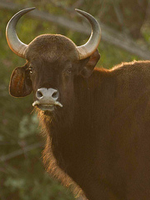 |
Gaur Description: A type of large wild-cattle, gaurs stand around 65 - 87 in (165 - 220cm) at the shoulder, and weigh around 1430 to 2200 lb (650 to 1000kg), though some may weigh more than that. They have medium-sized horns that are very sharp. Bulls are generally a dark brown to black color, with cows being several shades lighter - from a sandy brown to a medium brown. Cows give birth every other year, typically around September to March. Habitat: Evergreen or deciduous forests Behavior: Gaurs are diurnal and are most active during the peak daylight hours, with it being very rare to see one active at night. When threatened, they are very aggressive and bold, and a gaur will often call for help. Bulls and cows live separately, usually coming together only to breed. Cows can be in groups of more than 50 individuals, whereas bulls are much more likely to be solitary. Location: forested areas in the southern continent Rarity: uncommon |
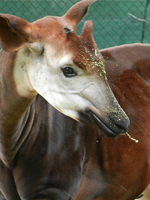 |
Okapi Description: Okapi are known for their stripes that are reminiscent of a zebra’s, though they are not related to zebras at all. They stand at 58 to 80 in at the shoulder, and weigh 440 to 720 lb. They are primarily chocolate brown to a reddish brown in color, with white stripes and bands going up their legs, with males also possessing very short, hair-covered horns. Females generally give birth to one calf, and will only breed about every other year. Offspring can be born at any time of the year. Habitat: canopy forests Behavior: Okapi are diurnal, being most active during the day but may also remain active for a few hours of the night. They are primarily solitary, meeting only when it is time for breeding. They do have overlapping home ranges, however, with male ranges being much larger than females. Males typically migrate while females do not. They are generally tranquil creatures, however when threatened, they can become aggressive and will kick or headbutt. Location: forested areas, never deserts or swamps Rarity: rare |
 |
Takin Description: The takin is an odd sort of creature that is often referred to as a ‘goat-antelope’ due to having characteristics of both species, though it is mostly closely related to sheep. They are stocky-bodied, with large heavy heads with a distinctive long, arched nose. The takin is very similar to the muskox in size, being 38 to 55 in (97 to 140cm) in height, and weigh around 570 - 770 lb (250 to 350kg). They vary widely in color, from a light cream to an almost black, though kids are darker and they tend to lighten as they age. All takin have a dark stripe on their back that makes it easy to distinguish them from other species. Both sexes have shiny black, crescent-shaped horns that grow from the center of their massive head and can reach up to 45” (90cm) in length. They have a strong, unique odor that smells something like a combination of horse and musk, and their skin secretes an oily, bitter-tasting substance that acts as a natural raincoat. In the early spring, a cow will give birth to a single kid or, rarely, twins. Within three days of birth, kids are able to follow their mothers through most types of terrain. Habitat: In the spring and summer, they migrate to rocky, grass covered areas at higher elevations, while in the fall and winter they congregate in forested areas where there is more food to be found. Behavior: Takin live in small groups of up to 20 individuals made up of both sexes, and oftentimes the offspring as well. However, it’s not uncommon for older males to strike out on their own. They are most active during early morning and late afternoon. During the spring and warm months, takins gather in large herds and migrate up to higher elevations, but as winter approaches they move back down to forested valleys. As they migrate across their range, they tend to use the same routes over and over, creating well-worn paths through the dense areas of bamboo and underbrush. When feeling threatened, takin will often flee and lay down into bamboo to disguise themselves, and they are quite nimble at leaping from rock to rock; however, if a hunter is able to corner one at a salt lick (which they frequent regularly) then it is quite easy to kill one - though you have to contend with the horns. Location: rocky areas and forested areas Rarity: uncommon |
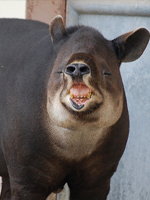 |
Tapir Description: Tapirs are medium-sized herbivores that are similar in appearance to pigs, but with a short, prehensile snout. They stand around 3’ (1m) high at the shoulder and weight 330-700lbs (150-300kg). They have short coats that range in color from grey to reddish-brown to nearly black, with babies having striped and spotted patterns for camouflage, and have thick skin on the backs of their necks to help ward off predators. Females give birth to a single calf every two years. Habitat: forest regions, often with close access to water Behavior: Tapirs are mostly nocturnal and crepuscular (active during twilight). Other than mothers and offspring, tapirs are almost exclusively solitary. When located near water, they spend a lot of their time in and under the water to feed and hide from predators, often sinking to the bottom to walk along the riverbed. Additionally they often wallow in mud pits to stay cool. When on land, they spend a lot of their waking hours seeking food along established trails. Tapirs are fairly fast despite their appearance, and when threatened will seek shelter in thick undergrowth or water. Location: forests, rivers or ponds near forests Rarity: common |
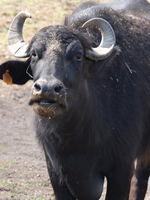 |
Water Buffalo Description: Wild water buffalo strongly resemble their domesticated descendants, though there are many differences both physically and temperamentally. They stand much larger than the domesticated breed at 59 to 75 in (150 to 190 cm) and weigh anywhere from 1,500 to 2,600 lb (700 to 1200 kg). They range from ash grey to black in color, and their hair is long and coarse. They have very large and wide horns that extend up to 79 in (2m) that can pose quite the danger while hunting them. As their name might suggest, they prefer living in more wet areas. They typically give birth every other year around the summer. Habitat: wet grasslands, swamps, densely vegetated river valleys Behavior: Water buffalo can be active during the day or at night, though they are the most active during the late afternoon and early evening. They lives in clans that can contain up to 30 buffalo, and are led generally by the older females. There may also be bachelor groups of up to ten males. Cows are very protective of their young, and will form protective lines around the calves until the thread is gone. If the threat persists, they will break off and run into the nearest vegetation. Location: wetlands Rarity: uncommon |
AUSTER
SMALL PREY
SMALL PREY
Rarity goes as follows: Common, moderate, uncommon, rare.
 |
Dik-dik Description: The dik-dik is a small antelope measuring 12-16” (30-40cm) at shoulder and weighing 7-16lbs (3-6kg) with females generally being slightly larger than the males. Males have small (approximately 3”) horns. The upper parts of their body are a grayish brown, while the lower parts including the underbelly and legs tend to be a tan color. A black spot beneath each eye contains scent glands that they use to mark their territories. They tend to give birth to a single offspring twice a year - once at the beginning of the rainy season and once at the end. Habitat: As they prefer foliage, shoots, fruits and berries rather than grass, dik-diks generally inhabit areas with large amounts of scrubland, occasionally dense woodlands and other places with plenty of cover and not very much tall grass. Behavior: Dik-diks usually live in pairs in established territories. Males mark the territories with distinctive piles of dung. These territories have plenty of cover and are usually in places with a lot of low shrubby bushes, or sometimes along dry streambeds. Their territories will have established paths through and around the borders of their territories for them to run quickly along when they are threatened. Dik-diks have excellent eyesight and are fast for their size, able to reach speeds around 26 mph. Location: shrubby areas and dense forests Rarity: moderate |
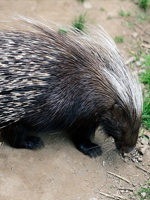 |
Southern Porcupine Description: The southern porcupine is a large arboreal rodent weighing around 9lbs and reaching lengths around 40”, though approximately half of that length is made up of their tail. Like their northern cousins, southern porcupines are covered in barbed quills interspersed among their fur. They are smaller than northern porcupines, and have a long, spineless prehensile tail that curves upward at the end to more easily grip tree branches. Their front and back paws are modified for grasping, these two adaptations making them quite adept at climbing. They tend to give birth to a single porcupette in the spring, with newborns covered in hair and soft quills that will begin to harden after birth. Habitat: They inhabit southern forests with plenty of trees. Behavior: Rarity: common |
AUSTER
WATERFOWL AND GAMEBIRDS
WATERFOWL AND GAMEBIRDS
Rarity goes as follows: Common, moderate, uncommon, rare.
 |
Peafowl Description: Peafowl are large, brightly colored birds. Peacocks are often 39-45” (100-115cm) long from beak to tail, and to the end of their train often as long as 77-89” (195-225cm) and weighing 8.8-13.2lbs (4-6kg). Peahens are a bit smaller, being around 37” (95cm) in length and weighing 6.1-88lbs (2.75-4kg). Males - which are mostly blue in color and have a crest of wire-like, tipped feathers on top of their heads - have a very distinctive train of elongated, stiff upper tail covert feathers with colorful “eye spots” that they can raise into a fan for displays. The males also have spurs on their legs above their hind toes. Females are much duller in appearance, bearing mostly shades of brown over much of their bodies with shades of metallic green on the lower neck and a green gloss on their dark brown breast feathers. They have a crest on their heads as well but it is not so brilliantly colored as the male. There are a few unusual color mutations in peafowl, including a mutation that produces melanism in the male and diluted color in the female, a pied mutation, and an all-white mutation. Peafowl are easily recognized from afar by their loud calls which are usually delivered when alarmed or in the presence of predators. Breeding is dependent on the rains, and clutches consist of 4-8 eggs. Habitat: Peafowl are generally found in forests but can adapt to living wherever food and water is available Behavior: Peafowl forage on the ground in small groups that typically have a single peacock and around three to five hens, although after the breeding season these flocks are often made up of only females and their young. They are most often found foraging in the open only in the early morning, and usually remain in cover during the rest of the day. At dusk, groups will walk single file to a favorite water hole to drink before taking to the trees to roost for the night. In the absence of tall trees they may often use rocks, buildings, or any other available high perch. When threatened they usually escape by running rather than flying away though they can often escape ground predators by flying into trees. Females have been known to carry her young into the safe roosts by carrying them on her back. Location: Rarity: moderate |